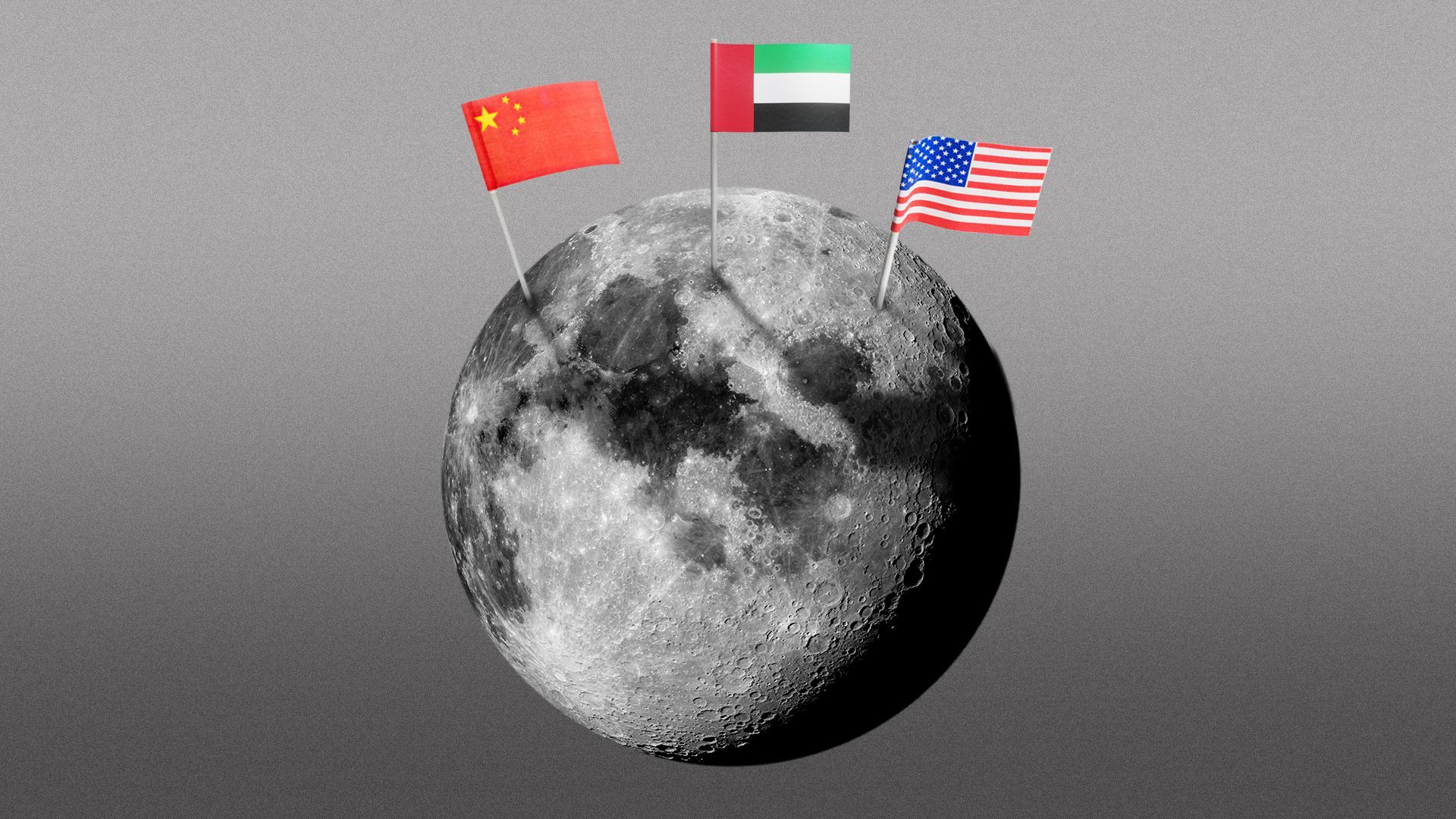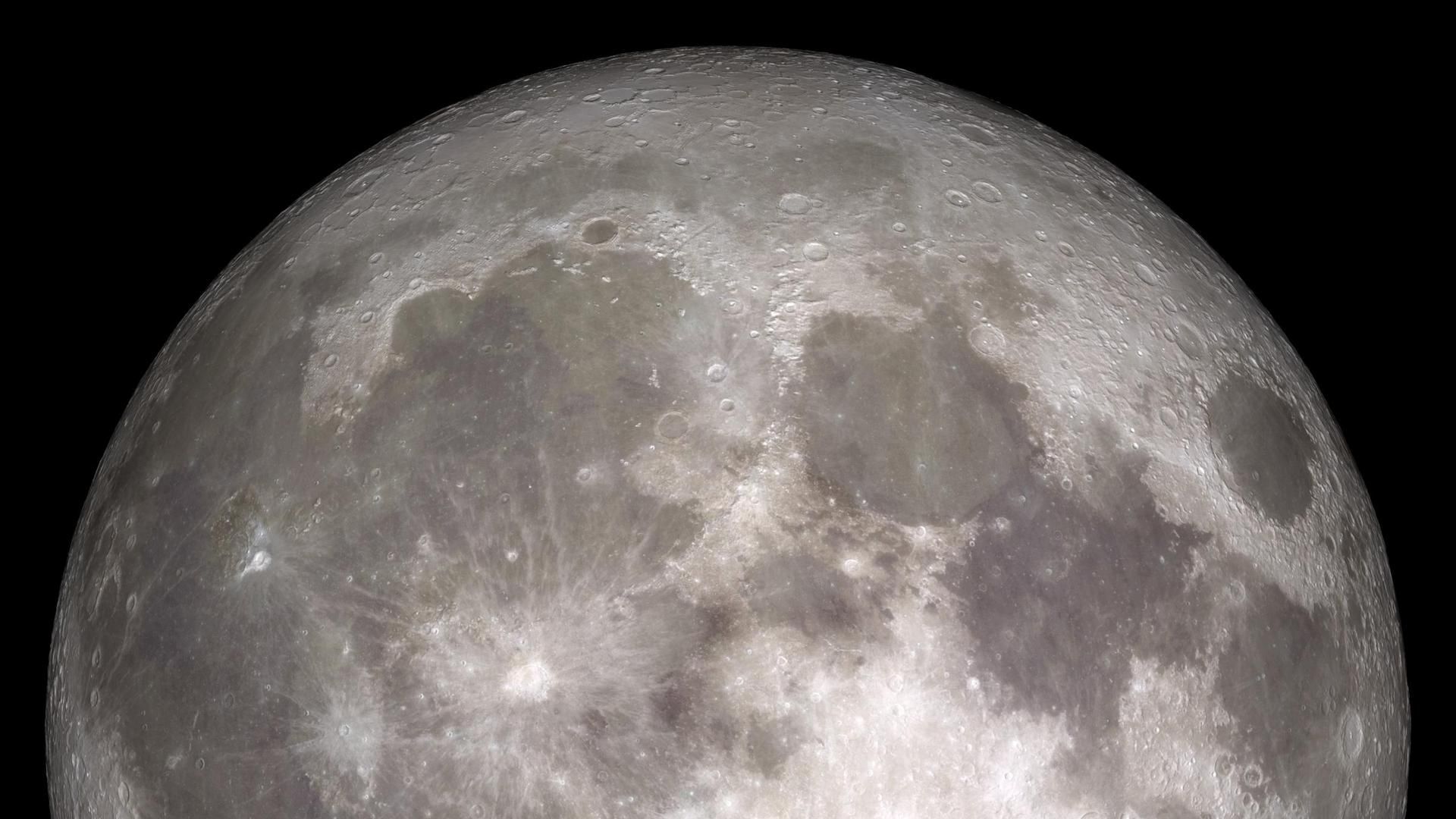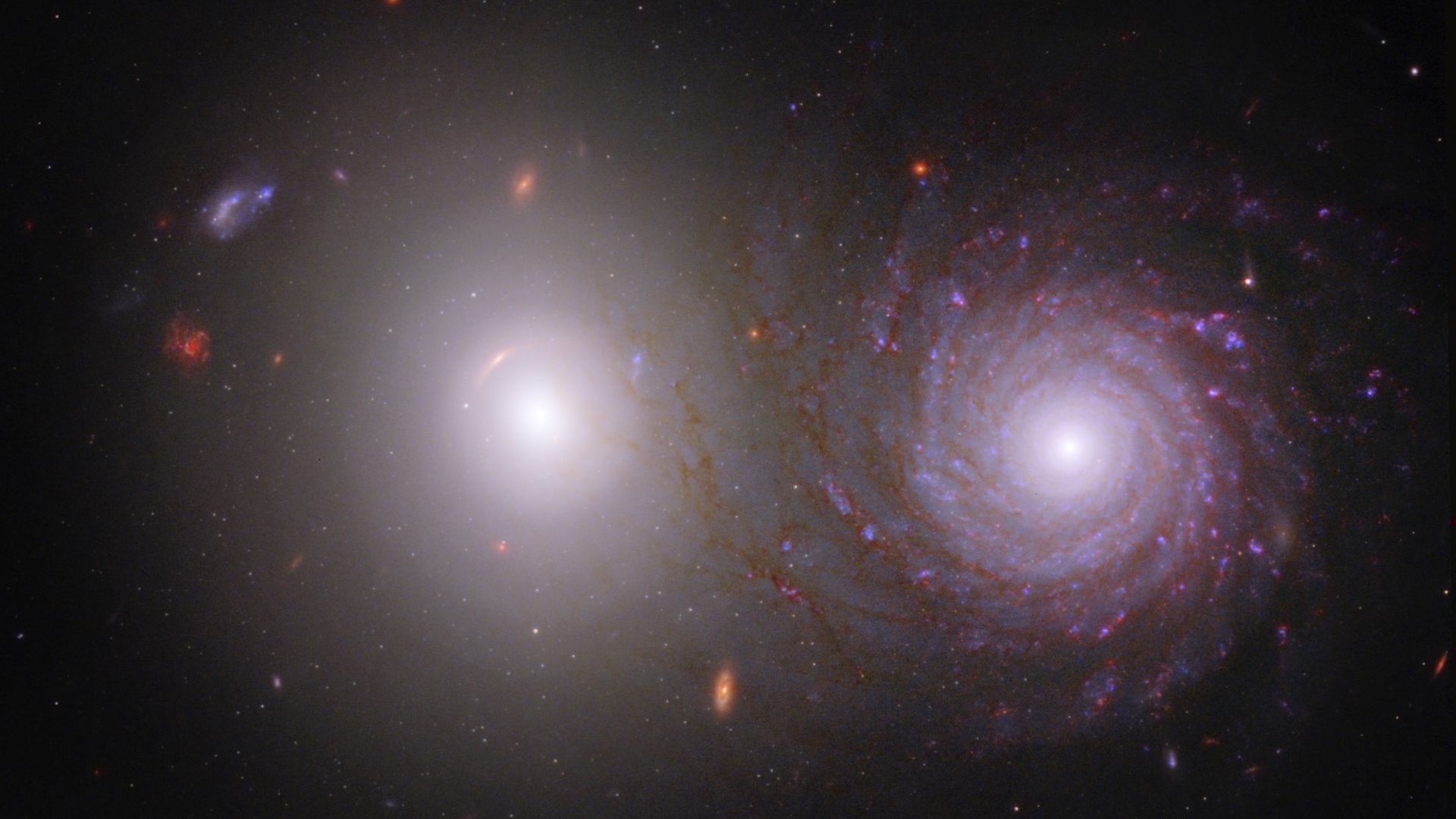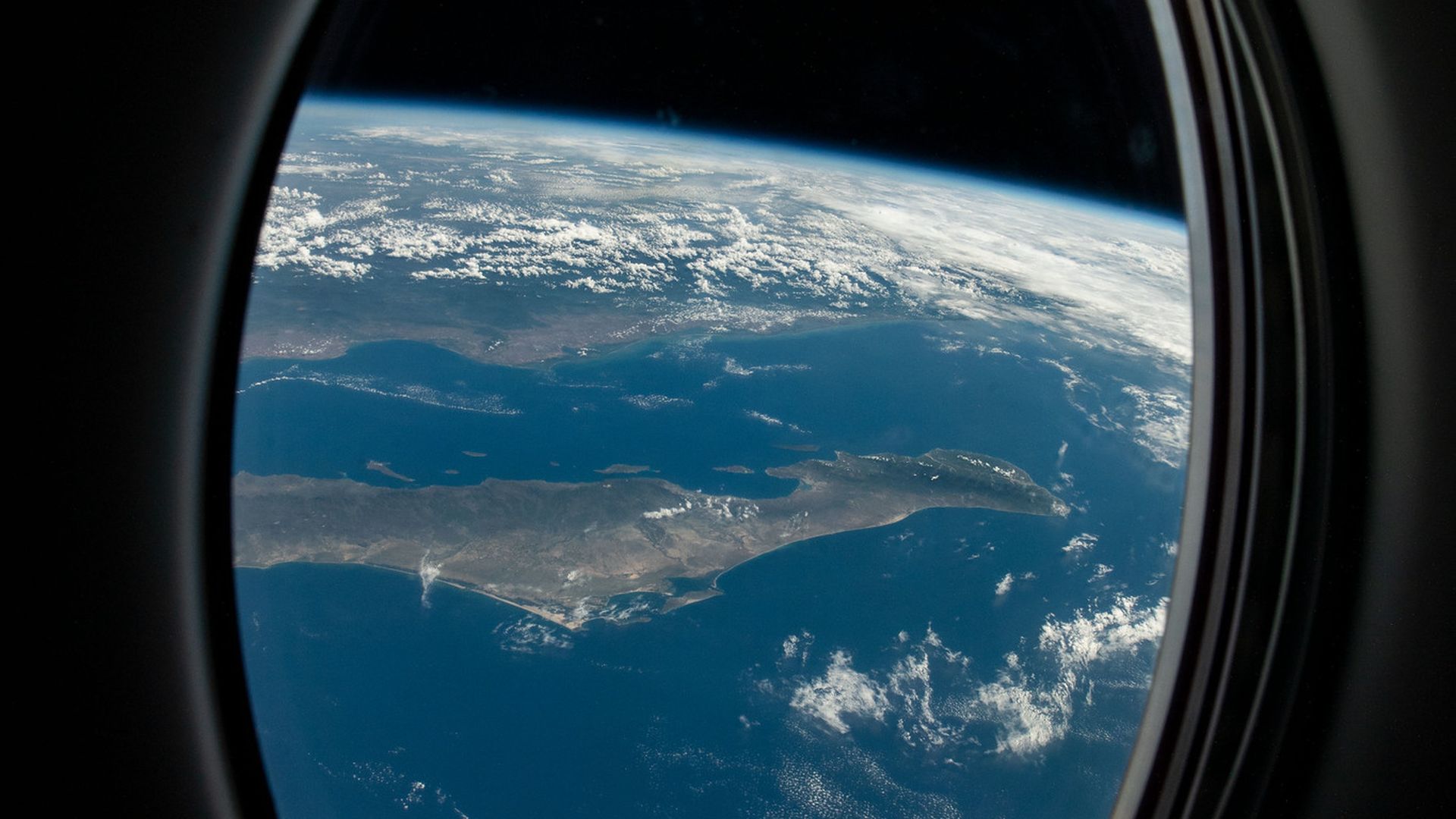| | | | | | | | | | | Axios Space | | By Miriam Kramer · Oct 11, 2022 | | Thanks for reading Axios Space. At 1,157 words, this newsletter is about a 4½-minute read. - Please send your tips, questions and infrared galaxy pics to miriam.kramer@axios.com, or if you received this as an email, just hit reply.
| | | | | | 1 big thing: The UAE straddles the line |  | | | Illustration: Natalie Peeples/Axios | | | | The United Arab Emirates is straddling geopolitical lines in space by working with China and the U.S. in their lunar ambitions. Why it matters: The UAE's partnerships with the U.S. and China could help bridge the gap between the two countries — which don't currently collaborate on space missions — and possibly help them work together informally in space. - As more nations aim to send people and spacecraft to the Moon in the coming years, communication about landing sites and the dust environment and a general situational awareness will become more important to make sure everyone stays safe.
Driving the news: The UAE recently announced it's planning to fly a rover to the Moon with China's Chang'e-7 mission, which is expected to launch around 2026. - The nation also signed on to the Artemis Accords in 2020, which is NASA's effort to try to govern resources and exploration of the Moon internationally.
- Twenty-one nations have signed the accords, which state that countries party to the agreement will openly share scientific data, provide aid if an emergency occurs on the Moon and use lunar exploration only for peaceful purposes.
- China and Russia are among the countries that have not signed the accords.
Details: The small UAE rover, named Rashid 2, will be preceded by the Rashid 1 rover. - The Rashid 1 rover is expected to fly to the Moon with Japan's ispace Hakuto-R lander aboard a SpaceX Falcon 9 rocket later this year.
- Instead of focusing on building rockets to launch its own satellites, the UAE has forged partnerships to build spacecraft and launch a space program that is already operating a probe orbiting Mars.
- The UAE didn't respond to questions in time for publication.
Between the lines: One of the architects of the Artemis Accords says he envisioned this kind of bridge-building when they were developing the agreement. - "We were hoping that the document could help influence even those who weren't a party to the program or signatories. And this is a potential good example of that because the UAE is committed to the principles of the accords," Mike Gold of Redwire Space, who helped craft the accords, tells Axios.
- Any UAE mission to the Moon should be in line with the accords, even if the nation works with a country that hasn't signed on, Gold added.
- "[T]his might be a way for [the UAE] to demonstrate leadership in terms of cooperative approaches in space at the ... global level," Victoria Samson of the Secure World Foundation tells Axios.
The big picture: Having nations straddle these lines in space could help if conflicts ever arise as the Moon becomes a more crowded place in the coming years. - NASA isn't able to bilaterally collaborate with China in space without a specific waiver from Congress due to the Wolf Amendment, first passed in 2011.
- The amendment was created, in part, to withhold space collaboration until China's human rights record improved.
- But the amendment has also created an additional politically divisive layer to collaboration, making it that much harder for the U.S. and China to work together in orbit and beyond.
|     | | | | | | 2. CAPSTONE stops its spin |  | | | The Moon. Image: NASA | | | | The small CAPSTONE spacecraft heading toward the Moon has stopped spinning out of control, marking a moment of success along the probe's road to recovery after a major malfunction last month. Why it matters: NASA is using CAPSTONE as a pathfinder for key elements of its Artemis program, expected to land people back on the Moon in 2025. - The spacecraft is designed to test a never-before-used orbit around the Moon that NASA hopes to one day use for its Gateway space station designed to be a jumping-off point for missions to the lunar surface.
Driving the news: Mission managers on Friday executed a fix to stop the spacecraft from spinning uncontrolled in space. - "CAPSTONE now has oriented its solar arrays to the Sun and adjusted the pointing of its antennas to provide a better data connection to Earth," NASA wrote in a blog post.
- The cause of the problem — which occurred on Sept. 8 — has been traced back to a valve in one of the spacecraft's eight thrusters. The mission team is now working to create a fix for it.
- CAPSTONE is still on track to make it into orbit around the Moon on Nov. 13.
The big picture: NASA is also working toward another major Artemis program moment this year. - The space agency is planning to launch its first flight of the Space Launch System rocket for its Artemis I mission in the middle of November.
- That mission has been delayed multiple times due to technical issues and Hurricane Ian's impact on Florida.
|     | | | | | | 3. Telescopes team up |  | | | A pair of galaxies and others in the background. Photo: NASA, ESA, CSA, Rogier Windhorst (ASU), William Keel (University of Alabama), Stuart Wyithe (University of Melbourne), JWST PEARLS Team | | | | The Hubble Space Telescope and James Webb Space Telescope have collaborated to map dust and light in two galaxies. Why it matters: Combining data from both telescopes will allow scientists to get a deeper understanding of stars, galaxies and other astronomical targets than they would by using a single telescope. What's happening: The two telescopes were used to observe the galaxy pair VV 191, which includes a white, somewhat diffuse elliptical galaxy (left in the image above) and a spiral galaxy not far from it. - The JWST's images of the pair were used to track light from the elliptical galaxy as it illuminated interstellar dust shaping the spiral galaxy.
- "Dust grains are partially responsible for the formation of new stars and planets, so we are always seeking to identify their presence for further studies," Rogier Windhorst, one of the scientists behind the observations, and the team said in a statement.
- The research team also discovered a very faint, warped galaxy magnified by the elliptical galaxy in this image. (The more distant galaxy is the red arc at about 10 o'clock within the central glow of the elliptical galaxy.)
How it works: These types of observations are possible because the Hubble and JWST look out into the universe in different wavelengths of light. - This image of VV 191, for example, uses ultraviolet imagery taken by the Hubble and infrared images taken by the JWST.
- The distant, warped galaxy wasn't visible in the Hubble images, but it stands out brightly in the JWST observations.
|     | | | | | | A message from Axios | | Business news worthy of your time | | |  | | | | Together, Axios Markets, Axios Macro, and Axios Closer decipher what the daily deluge of news, statistics, and analysis really means — and why it matters. Subscribe for free | | | | | | 4. Out of this world reading list |  | | | Four crew members ahead of their launch to the ISS. Photo: SpaceX | | | | 🐉 NASA's Titan Dragonfly will touch down on a field of dunes and shattered ice (Keith Cooper, Space.com) ✨ Graveyard of ancient stars uncovered in the Milky Way (Ashley Strickland, CNN) 💰 Space companies face difficult investment environment (Jeff Foust, SpaceNews) 🎮 A Minecraft player set out to build the known universe, block by block (April Rubin, New York Times) 🚀 SpaceX launches Crew-5 mission for NASA (Michael Sheetz, CNBC) |     | | | | | | 5. Weekly dose of awe: Through the window |  | | | Photo: NASA | | | | That's not the view out of an airplane. - This photo was taken from the window of a SpaceX Crew Dragon capsule attached to the International Space Station as the ISS passed over Baja California Sur and the Gulf of California.
The big picture: SpaceX has said its goal is to one day make space travel more akin to air travel, with civilians and professionals flying to orbit — and beyond — regularly. |     | | | | | | A message from Axios | | Business news worthy of your time | | |  | | | | Together, Axios Markets, Axios Macro, and Axios Closer decipher what the daily deluge of news, statistics, and analysis really means — and why it matters. Subscribe for free | | | | Big thanks to Alison Snyder for editing and Sheryl Miller for copy editing, and to Natalie Peeples for the illustration. If this newsletter was forwarded to you, subscribe. 🌌 |  | | Are you a fan of this email format? It's called Smart Brevity®. Over 300 orgs use it — in a tool called Axios HQ — to drive productivity with clearer workplace communications. | | | | | | Axios thanks our partners for supporting our newsletters. If you're interested in advertising, learn more here.
Sponsorship has no influence on editorial content. Axios, 3100 Clarendon Blvd, Arlington VA 22201 | | | You received this email because you signed up for newsletters from Axios.
Change your preferences or unsubscribe here. | | | Was this email forwarded to you?
Sign up now to get Axios in your inbox. | | | | Follow Axios on social media:    | | | | | |
No comments